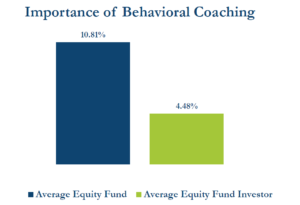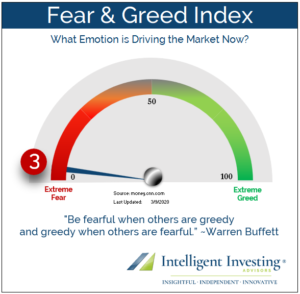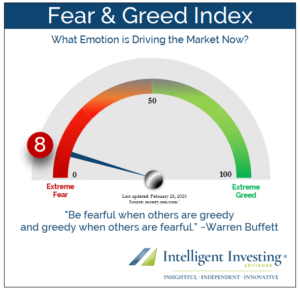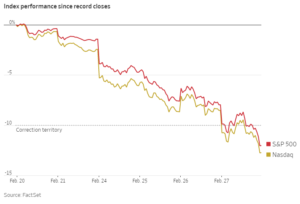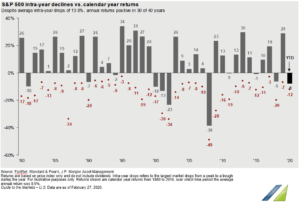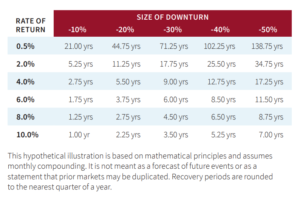
Reading Time: 5 minutes
Unfortunately, the coronavirus isn’t simply a threat to our physical well-being, it’s also a direct threat to our pocketbooks. And it’s not just working-age Americans who could suffer the consequences. Seniors readying to retire could be forced into unwanted decisions as a direct result of coronavirus mitigation measures.
The closure of nonessential businesses has put many people out of work in a very short period of time. over 10 million people have filed jobless claims, and with more job losses to come and little certainty as to when economic activity will return to normal, unemployed workers will need income. For some, the answer will be unemployment benefits. As part of the Coronavirus Aid, Relief, and Economic Security (CARES) Act, $260 billion was apportioned to bolster the unemployment program and boost weekly payouts by $600 for the next four months.
Unfortunately, some may not have the luxury of choosing when to retire, and many will be forced to retire early. For others who were planning on retiring in the next year or two, they may need to delay retirement. This article is to help those who may be thinking about retiring, as well as for those who will be or have been forced to retire early.
Deciding when to retire may not be one decision but a series of decisions and calculations. For example, you’ll need to estimate not only your anticipated expenses, but also what sources of retirement income you’ll have and how long you’ll need your retirement savings to last. You’ll need to take into account your life expectancy and health as well as when you want to start receiving Social Security or pension benefits, and when you’ll start to tap your retirement savings. Each of these factors may affect the others as part of an overall retirement income plan.
Thinking about early retirement?
Retiring early means fewer earning years and less accumulated savings. Also, the earlier you retire, the more years you’ll need your retirement savings to produce income. And your retirement could last quite a while. According to a National Vital Statistics Report, people today can expect to live more than 30 years longer than they did a century ago.
Not only will you need your retirement savings to last longer, but inflation will have more time to eat away at your purchasing power. If inflation is 3% a year — its historical average since 1914 — it will cut the purchasing power of a fixed annual income in half in roughly 23 years. Factoring inflation into the retirement equation, you’ll probably need your retirement income to increase each year just to cover the same expenses. Be sure to take this into account when considering how long you expect (or can afford) to be in retirement.
Current Life Expectancy Estimates
| Men | Women | |
| At birth | 76.1 | 81.1 |
| At age 65 | 83.1 | 85.6 |
Source: NCHS Data Brief, Number 328, November 2018
There are other considerations as well. For example, if you expect to receive pension payments, early retirement may adversely affect them. Why? Because the greatest accrual of benefits generally occurs during your final years of employment, when your earning power is presumably highest. Early retirement could reduce your Social Security benefits too.
Also, don’t forget that if you hope to retire before you turn 59½ and plan to start using your 401(k) or IRA savings right away, you’ll generally pay a 10% early withdrawal penalty plus any regular income tax due (with some exceptions, including disability payments and distributions from employer plans such as 401(k)s after you reach age 55 and terminate employment) Due to the Coronavirus and recent legislation, the early withdrawal penalty may not apply, so be sure to check with your CPA.
Finally, you’re not eligible for Medicare until you turn 65. Unless you’ll be eligible for retiree health benefits through your employer or take a job that offers health insurance, you’ll need to calculate the cost of paying for insurance or health care out-of-pocket, at least until you can receive Medicare coverage.
Delaying retirement
Postponing retirement lets you continue to add to your retirement savings. That’s especially advantageous if you’re saving in tax-deferred accounts, and if you’re receiving employer contributions. For example, if you retire at age 65 instead of age 55, and manage to save an additional $20,000 per year at an 8% rate of return during that time, you can add an extra $312,909 to your retirement fund. (This is a hypothetical example and is not intended to reflect the actual performance of any specific investment.)
Even if you’re no longer adding to your retirement savings, delaying retirement postpones the date that you’ll need to start withdrawing from them. That could enhance your nest egg’s ability to last throughout your lifetime.
Postponing full retirement also gives you more transition time. If you hope to trade a full-time job for running your own small business or launching a new career after you “retire,” you might be able to lay the groundwork for a new life by taking classes at night or trying out your new role part-time. Testing your plans while you’re still employed can help you anticipate the challenges of your post-retirement role. Doing a reality check before relying on a new endeavor for retirement income can help you see how much income you can realistically expect from it. Also, you’ll learn whether it’s something you really want to do before you spend what might be a significant portion of your retirement savings on it.
Phased retirement: the best of both worlds
Some employers have begun to offer phased retirement programs, which allow you to receive all or part of your pension benefit once you’ve reached retirement age, while you continue to work part-time for the same employer.
Phased retirement programs are getting more attention as the baby boomer generation ages. In the past, pension law for private sector employers encouraged workers to retire early. Traditional pension plans generally weren’t allowed to pay benefits until an employee either stopped working completely or reached the plan’s normal retirement age (typically age 65). This frequently encouraged employees who wanted a reduced workload but hadn’t yet reached normal retirement age to take early retirement and go to work elsewhere (often for a competitor), allowing them to collect both a pension from the prior employer and a salary from the new employer.
However, pension plans now are allowed to pay benefits when an employee reaches age 62, even if the employee is still working and hasn’t yet reached the plan’s normal retirement age. Phased retirement can benefit both prospective retirees, who can enjoy a more flexible work schedule and a smoother transition into full retirement; and employers, who are able to retain an experienced worker. Employers aren’t required to offer a phased retirement program, but if yours does, it’s worth at least a review to see how it might affect your plans.
Check your assumptions
The sooner you start to plan the timing of your retirement, the more time you’ll have to make adjustments that can help ensure those years are everything you hope for. If you’ve already made some tentative assumptions or choices, you may need to revisit them, especially if you’re considering taking retirement in stages. And as you move into retirement, you’ll want to monitor your retirement income plan to ensure that your initial assumptions are still valid, that new laws and regulations haven’t affected your situation, and that your savings and investments are performing as you need them to.
Forced Into Retirement?
If you have been forced into retirement from your employer, please understand that you have many options and decisions to make. Unfortunately, most pre-retirees are not equipped to handle the situation on their own–both from a financial knowledge base or from an emotional standpoint. As we have done for our current clients, we would be honored to help you sort through your various options: from Social Security benefits decisions to 401k or 403b rollover options. Please consider giving us a call or scheduling a meeting at your convenience by clicking the button below.
Schedule a short discovery call or meetingSource: Some of the material used comes from Broadridge Investor Communication Solutions, Inc.


